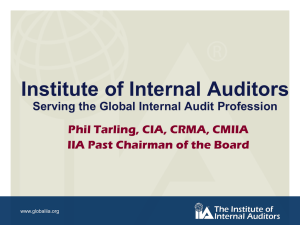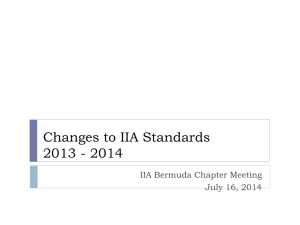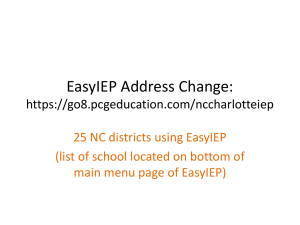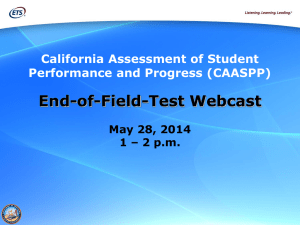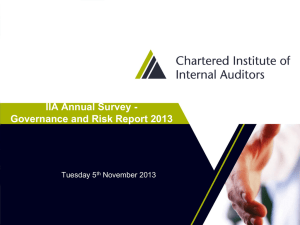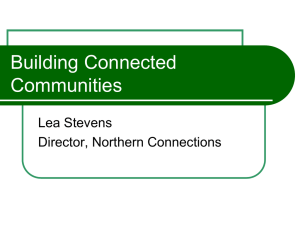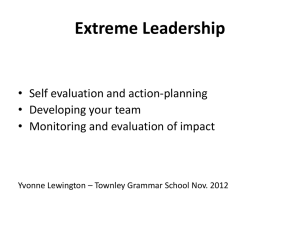Title IIA Overview
advertisement
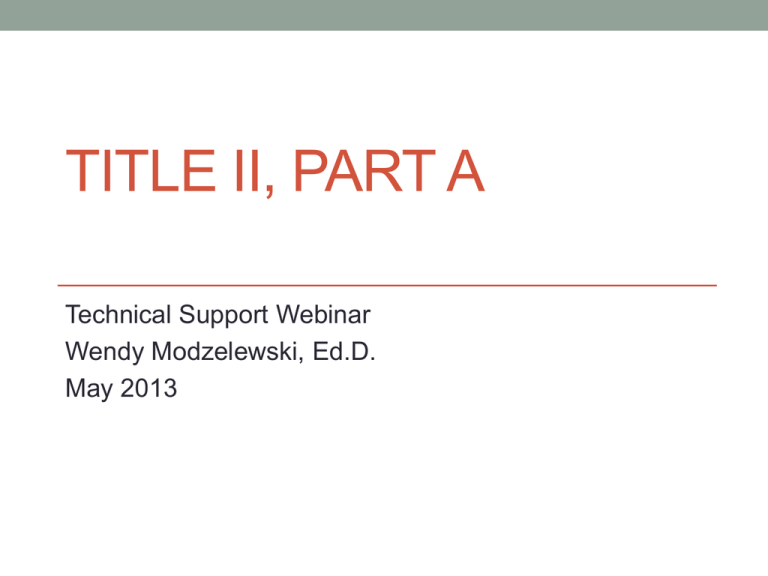
TITLE II, PART A Technical Support Webinar Wendy Modzelewski, Ed.D. May 2013 Title IIA – Acceptable Use of Funds In general, funds may be used to: • Promote a teaching staff that is highly qualified and able to help all students – regardless of individual learning needs – achieve challenging State content and academic achievement standards. • Funding can also be used to provide school principals with the knowledge and skills necessary to lead their schools’ efforts in increasing student academic achievement. Improving Teacher Quality State Grants Non-Regulatory Guidance (October 5, 2006); Section E-1 Title IIA – Acceptable Uses of Funds 1. Developing and implementing mechanisms to assist schools to effectively recruit and retain highly qualified teachers, principals, and specialists in core academic areas. Title IIA – Acceptable Uses of Funds 2. Developing and implementing strategies and activities to recruit, hire, and retain highly qualified teachers and principals. For Example: • Providing monetary incentives such as scholarships, signing bonuses, or differential pay for teachers in academic subjects or schools in which the LEA has shortages; • Reducing class size; • Recruiting teachers to teach special needs children, including students with disabilities, and • Recruiting qualified paraprofessionals and teachers from populations underrepresented in the teaching profession, and providing those paraprofessionals with alternate routes to obtaining teacher certification. Title IIA – Acceptable Uses of Funds 3. Providing professional development activities that improve the knowledge of teachers and principals and, in appropriate cases, paraprofessionals, in: a. Content knowledge. Providing training in one or more of the core academic subjects that the teachers teach; and b. Classroom practices. Providing training to improve teaching practices and student academic achievement through (a) effective instructional strategies, methods, and skills, and (b) the use of challenging State academic content standards and student academic achievement standards in preparing students for the State assessments. Title IIA – Acceptable Uses of Funds 4. Providing professional development activities that improve the knowledge of teachers and principals and, in appropriate cases, paraprofessionals, regarding effective instructional practices that: a. Involve collaborative groups of teachers and administrators; b. Address the needs of students with different learning styles, particularly students with disabilities, students with special needs (including students who are gifted and talented), and students with limited English proficiency; c. Provide training in improving student behavior in the classroom and identifying early and appropriate interventions to help students with special needs; d. Provide training to enable teachers and principals to involve parents in their children’s education, especially parents of limited English proficient and immigrant children; and e. Provide training on how to use data and assessments to improve classroom practice and student learning. Title IIA – Acceptable Uses of Funds 5. Developing and implementing initiatives to promote retention of highly qualified teachers and principals, particularly in schools with a high percentage of lowachieving students, including programs that provide teacher mentoring from exemplary teachers and administrators, induction, and support for new teachers and principals during their first three years; and financial incentives to retain teachers and principals with a record of helping students to achieve academic success. Title IIA – Acceptable Uses of Funds 6. Carrying out programs and activities that are designed to improve the quality of the teaching force, such as innovative professional development programs that focus on technology literacy, tenure reform, testing teachers in the academic subject in which teachers teach, and merit pay programs. Title IIA – Acceptable Uses of Funds 7. Carrying out professional development programs that are designed to improve the quality of principals and superintendents, including the development and support of academies to help them become outstanding managers and educational leaders. Title IIA – Acceptable Uses of Funds 8. Hiring highly qualified teachers, including teachers who become highly qualified through State and local alternate routes to certification, and special education teachers, in order to reduce class size, particularly in the early grades. Title IIA – Acceptable Uses of Funds 9. Carrying out teacher advancement initiatives that promote professional growth and emphasize multiple career paths (such as paths to becoming a mentor teacher, career teacher, or exemplary teacher) and pay differentiation. Improving Teacher Quality State Grants Non-Regulatory Guidance (October 5, 2006); Section E-1 Title IIA – Critical Components NEEDS ASSESSMENT FINDINGS TITLE IIA BUDGET EXPENDITURES PLAN: 1. 2. 3. 4. PD plan Recruitment Retention Class Size Reduction Title IIA – Needs Assessment • Must conduct a Needs Assessment • Describe the needs assessment process • List the Committee members: Administrators, teachers, paraprofessionals, parents, other staff • Must use and list data sources • Must include high needs schools • May use surveys to gather information Title IIA – Needs Assessment Findings • State the findings of the Needs Assessment • Student needs • Faculty needs • School needs (e.g. behavioral plan) Title IIA – Design PD Plan • Design PD that is aligned to the findings from the needs assessment • Include: PD for teachers, paraprofessionals, school administrators and the superintendent (not district staff) • List how time is allocated for PD (e.g. PLCs, in-service, after school time, weekends, etc.) • Include total average number of hours Title IIA – Design PD Plan • You may have up to six (6) PD priorities • For each priority: • Describe the PD activity • PD described must be research-based • List who will participate • List the source of funding, including supplemental local funds • PD must align to one of IIA’s acceptable goals Title IIA –Acceptable Goals for PD Goals Checklist: 1. Improve student academic achievement and eliminate achievement gaps. 2. Help teachers address the needs of students with different learning styles. 3. Help teachers improve student behavior in the classroom. 4. Help teachers involve parents in their child's education. 5. Help teachers understand and use data and assessments to improve classroom practice and student learning. 6. Help teachers effectively integrate technology into curricula and instruction. 7. Provide principals with instructional leadership skills. Title IIA – Educator Outcome(s) • State the educator outcome that is intended from the PD • Must have a quantifiable measure • Must have a quantifiable target • Must have a methodology for evaluating that target (who, how, when, etc.) Title IIA – Student Outcome(s) • State how the PD will have a substantial, measurable, and positive impact on student achievement • Must have a quantifiable measure • Must have a quantifiable target • Must have a methodology for evaluating that target (who, how, when, etc.) Title IIA – Designing PD Repeat, as needed, for up to each of six (6) PD priorities. Title IIA - Budget Expenditures must be: • Reasonable • Necessary • Allowable • Aligned to requirements of Title II, Part A In general: • Be as specific as possible • Provide as much detail as possible • Align budget items to your Needs Assessment Title IIA – Past Budget Issues • Funding allocations with insufficient details • Conferences: Name of event, registration fees, travel, hotels, attendees, etc. • Professional Development: PD Provider, fees, topic, dates, attendees, etc. • Substitutes: Description/title of PD, rate, hours • Supplies & Materials: Description/title of PD, description of items, costs Title IIA – Past Budget Issues • Funding People • Teachers – Must be HQ • Instructional Coaches – Should be okay • District Staff – Only the FTE for Title IIA Activity • Secretaries – only the FTE for Title IIA Activity • Technical Support – Only the FTE that is supporting hardware used exclusively for Title IIA PD • With the exception of teachers, LEA must maintain Time and Effort reporting Title IIA – Past Budget Issues • Purchasing Hardware • Not allowed except under extenuating circumstances • Email or call me prior to including this in your budget Special Notes • May apply indirect costs • May budget audit fees if they are proportional to the amount of funds received for the program in relation to other programs. Other Sections I Will Review • 2.1 – Planning Team • 2.2 – Selection of programs • 2.3 – Program Coordinators & Allocations • 2.4 – Indirect Costs • 2.9 – Equitable Services • 4.0 – Budget Any questions on Title IIA? EQUITABLE SERVICES AND TITLE IIA Equitable Services • Private School students and teachers are eligible to participate • • • • in certain federal education programs. From: Title IX, Part E, Subpart 1 of ESEA Viewed as a process; not a one-time event Applies only to the LEA’s IIA funds to the extent that the LEA uses these funds for PD of its teachers and other staff but LEA must minimally meet “hold harmless” amount The LEA administers and maintains control of the funds Consultation • • • • LEAs MUST reach out to privates EVERY year It is the LEA’s responsibility to provide equitable services. LEA contacts officials of private schools within its jurisdiction. Begin the “timely and meaningful” consultation BEFORE the LEA makes any decisions about expenditures • Start early enough to allow for participation of private school teachers at the start of the school year. Topics for Consultation • • • • How the children and teacher needs will be identified; What services will be offered; How, where, and by whom the services will be provided; How the services will be assessed and how the results of the assessment will be used to improve those services; • The size and scope of the equitable services to be provided to the eligible private school; • The amount of funds available for those services; and • How and when the LEA will make decisions about the delivery of services What MAY privates do with the funds? • Must meet the requirements of the statute. • Activities should be based on scientifically based research. • Must be expected to improve student academic achievement. • Supplement non-federal funds (not supplant local funds) What may private schools NOT do with the funds? • They cannot pay a portion of the private school teacher’s • • • • salary or benefits. They cannot pay for substitutes They cannot pay for admin costs of the funds; that is the LEAs responsibility They cannot pay contractor’s administrative costs May not supplant local funds How do you know your LEA is providing equitable services? • Assess, address, and evaluate the needs and progress of both public & private school teachers; • Spend an equal amount of funds per student to serve the needs of public and private school teachers; • Provide private school teachers with an opportunity to participate in title II activities equivalent to the opportunity provided public school teachers; and • Offer education services to private school teachers that are secular, neutral, and non-ideological Does the private school’s PD have to be the same as the LEA? • No. Consultation is critical to ensure that their needs are being met. • LEAs must assess the needs of private school teachers in designing the PD program for private school teachers. • If the PD needs between the privates and the LEA are different, in consultation with the privates, design a separate program. How Much Should an LEA Share? • LEAs provide equitable services only to the extent that they use the funds for PD. • The following services are considered PD and are subject to Equitable Services provisions: • • • • • • Salaries of PD coaches Mentor teachers who provide PD Special Ed Mentor Coaches Staff development in core content areas Teacher leadership programs Professional learning communities • BUT… There is a Minimum • The statute requires that an LEA spend at least as much for professional development under Title II, Part A as it did in fiscal year (FY) 2001 under the former Eisenhower Professional Development and Class-Size Reduction programs. (See Title IX, Section 9501(b)(3)(B).) • This amount is called the “Hold Harmless” amount. Examples of Calculating Equitable Services A. Number of Students A1. District Enrollment A2. Participating Private School Enrollment A3. Total Enrollment (A1 + A2) B. Title II, Part A Allocation To Be Used for Professional Development B1. District Allocation B2. Indirects and Administration (for Public and Private programs) + Class Size Reduction + Recruitment Activities B3. Amount District is Using for Professional Development (B1 – B2) C. Hold Harmless Amount C1. Based on FY2001 Eisenhower Professional Development + Federal Class Size Reduction used for Professional Development D. Per Pupil Rate D1. Use either B3 or C1 – whichever is LARGER (Divide by A3) E. Equitable Services E1. Amount District must reserve for equitable services for participating private schools (A2 X D1) Example A 960 40 1,000 Example B 960 40 1,000 $150,000 $150,000 $130,000 $20,000 $50,000 $100,000 $40,000 $40,000 $40 $100 $1,600 $4,000 What are the LEA’s record-keeping responsibilities? Document that: • Private schools were informed of the availability of Title II, Part A services • Needs of private and public school teachers were identified as part of a district-wide needs assessment • Private school officials were consulted and provided the chance for input into planning of the LEA’s program activities • LEA designed a project that would permit equitable participation • LEA attempted to resolve any complaints made by private school representatives What documents that are available to assist your LEA? • Title IX, Part E Uniform Provisions; Subpart 1 – Private Schools Non- Regulatory Guidance • Documents • Before Getting Started • Timeline for LEA Consultation • Consultation Timeline • Consultation Checklist • Needs Assessment & Program Development Plan • Intent to Participate for Private Schools • Consultation Checklist for Private School Officials • ESEA program Complaint Procedures for Private Schools Any questions on Equitable Services for Title II, Part A? Thank you for attending. Please contact me if you have any questions. Wendy Modzelewski (302)857-3305
